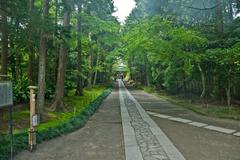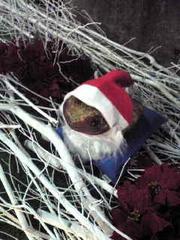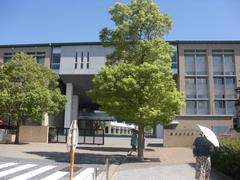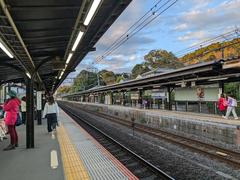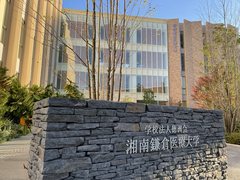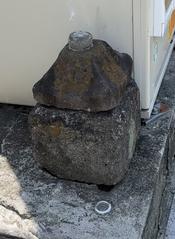Sunshodo Kamakura Visiting Hours, Tickets, and Travel Guide
Date: 14/06/2025
Introduction
Sunshodo in Kamakura stands as a living testament to Japan’s rich heritage of craftsmanship and spirituality. Nestled amidst the city’s renowned temples and shrines, Sunshodo offers visitors an immersive experience into Kamakura’s artisanal past—particularly the tradition of Kamakurabori woodcarving and calligraphy. This guide provides detailed, up-to-date information on visiting hours, ticketing, accessibility, and tips for making the most of your visit to Sunshodo and surrounding historical sites. For further reading, see the Kamakura City Tourist Association and Japan Experience.
Table of Contents
- Introduction
- Kamakura and Sunshodo: Historical & Cultural Overview
- Visiting Sunshodo: Practical Information
- Activities & Experiences
- Nearby Kamakura Attractions
- Visitor Tips
- Accessibility Details
- Frequently Asked Questions (FAQ)
- Conclusion
- References
Kamakura and Sunshodo: Historical & Cultural Overview
Kamakura’s Historical Significance
Kamakura, located southwest of Tokyo, flourished as the seat of Japan’s first shogunate during the Kamakura Period (1185–1333). This era saw the rise of the samurai, the introduction of Zen Buddhism, and the blossoming of unique cultural and religious traditions (World History Encyclopedia; Britannica).
Kamakurabori: The Art of Woodcarving
Kamakurabori, Kamakura’s distinctive woodcarving style, began as a craft to supply Buddhist temples with intricate ritual implements. Characterized by detailed carving and lacquer finishes, it reflects the Zen ideals of simplicity and natural beauty. Kamakurabori remains a symbol of Kamakura’s artisanal identity (Kamakura City Tourist Association).
The Role of Sunshodo
Founded in the early 20th century, Sunshodo both preserves and innovates within Kamakurabori and traditional calligraphy. The shop’s architecture combines Japanese and Western influences—an emblem of Kamakura’s evolving history. It serves as a workshop, retail space, and educational hub, connecting visitors with local craftsmanship (Kamakura City Tourist Association).
Visiting Sunshodo: Practical Information
Location & Getting There
- Address: 1-7-23 Ogigaya, Kamakura City, Kanagawa Prefecture
- Nearest Station: Kamakura Station (JR Yokosuka Line, Shonan Shinjuku Line, Enoden Line)
- Access: 5–20 minutes on foot from Kamakura Station, or via local Enoden train to Hase Station (Japan Horizon; Trip to Japan)
For those traveling from Tokyo, take the JR Yokosuka Line (approx. 1 hour, ¥940 one way; Japan Rail Pass applicable). From Shinjuku, the Odakyu Enoshima-Kamakura Freepass offers unlimited rides and easy transfers via Enoden (asianwanderlust.com; mytravelbuzzg.com).
Visiting Hours & Tickets
- Opening Hours: Typically 10:00 AM – 5:00 PM (may vary seasonally; last admission often 30 minutes before closing)
- Admission: Free for general entry; workshops and special events may require a participation fee (¥1,000–¥3,000 depending on activity)
- Tickets: Purchase on-site; online booking is generally not available
- Guided Tours: Staff can provide background and explanations in Japanese; some English support may be available
- Photography: Allowed in most areas, but ask permission before photographing artisans or workshops
Confirm current hours and events by checking the Kamakura City Tourist Association or Sunshodo’s official website before visiting.
Accessibility
- Physical Access: The main floor is generally accessible, but steps and uneven surfaces may be present. Assistance is available upon request.
- Parking: No dedicated parking; use nearby paid lots or public transportation
- Wheelchair Users: Contact ahead for assistance (Japan Guide)
Visitor Etiquette
- Remove shoes before entering traditional spaces
- Handle artifacts and crafts with care; follow staff instructions
- Keep quiet and respect the meditative atmosphere
- Participation in workshops is encouraged, but always be mindful of cultural protocols
Activities & Experiences
Workshops and Demonstrations
- Calligraphy Workshops: Learn shodō (Japanese calligraphy) under guidance from local masters; suitable for all levels
- Kamakurabori Carving: Observe or try your hand at basic woodcarving techniques
- Tea Ceremony & Incense Sessions: Experience traditional Japanese hospitality and Kōdō (incense appreciation) (Japan Horizon)
Reservations are recommended, especially in peak seasons.
Seasonal Events
- Hydrangea Viewing (June): Sunshodo’s garden and surrounding area are renowned for vibrant hydrangea blooms
- Cultural Festivals: Kamakura hosts festivals and light-up events, with Sunshodo sometimes participating or collaborating (Kamakura seasonal events)
Souvenirs & Local Products
Sunshodo offers high-quality, handmade calligraphy sets, brushes, inkstones, washi paper, and Kamakurabori carvings. Purchases directly support local artisans and heritage preservation.
Nearby Kamakura Attractions
- Tsurugaoka Hachimangu Shrine: Central to Kamakura’s spiritual life, located a short walk from Sunshodo (Live Japan)
- Great Buddha (Kotoku-in): Iconic 11.3-meter bronze statue, a must-see for visitors
- Hasedera Temple: Celebrated for gardens and panoramic coastal views
- Komachi-dori Street: Bustling shopping lane with local snacks and crafts
- Meigetsu-in (Hydrangea Temple): Famed for its June blooms
Combine your Sunshodo visit with these sites for a comprehensive Kamakura experience (Japan Travel; My Japan Guide).
Visitor Tips
What to Wear & Bring
- Comfortable shoes (some uneven paths)
- Modest clothing suitable for sitting on tatami mats
- Umbrella/raincoat (especially in June)
- Cash (many small venues do not accept cards)
- Reusable water bottle, camera, and a notebook/sketchbook
Food & Refreshments
Komachi-dori offers local specialties such as shirasu (whitebait) bowls and Hato Sabure cookies. Vegetarian and vegan options are available but limited (jw-webmagazine.com).
Accommodation
To fully enjoy Kamakura, consider an overnight stay at a ryokan, guesthouse, or hotel near Hase or Kamakura Station. Book early during peak seasons.
Safety & Environmental Considerations
Kamakura is generally safe. Dispose of trash properly, stay on marked paths, and respect local customs and wildlife.
Accessibility Details
Sunshodo’s building is traditional and may have some steps and gravel paths. While the main floor is accessible, those with mobility challenges are advised to call ahead. The Kamakura Tourist Information Center near Kamakura Station provides maps and assistance in English (Japan Guide).
Frequently Asked Questions (FAQ)
Q: What are Sunshodo’s opening hours?
A: Usually 10:00 AM–5:00 PM; check for seasonal or special event changes.
Q: Is there an admission fee?
A: Entry is free; workshops and events may require a fee.
Q: Are workshops suitable for beginners?
A: Yes, most are beginner-friendly and may offer English-language support.
Q: How accessible is Sunshodo?
A: The main floor is accessible, but contact ahead for specific needs.
Q: Can I take photos?
A: Generally yes, but always ask before photographing people or during workshops.
Q: What’s the best season to visit?
A: June for hydrangeas; spring and autumn for mild weather and scenic gardens.
Conclusion
A visit to Sunshodo in Kamakura is more than a sightseeing stop—it’s an invitation to engage with Japan’s living traditions of craftsmanship, spirituality, and community. Whether exploring the artistry of Kamakurabori, participating in a calligraphy workshop, or simply enjoying the tranquil gardens, Sunshodo offers a window into the soul of Kamakura. Combine your visit with nearby historic landmarks for a memorable journey through Japan’s cultural heart.
For up-to-date information, workshop reservations, and cultural event details, consult the Kamakura City Tourist Association and consider downloading the Audiala app for guided tours and insider tips.
References
- Kamakura City Tourist Association
- Japan Experience
- Britannica
- Live Japan
- The Travel Blogs
- Trip to Japan
- Japan Horizon
- Japan Guide
- asianwanderlust.com
- mytravelbuzzg.com
- jw-webmagazine.com
- My Japan Guide
